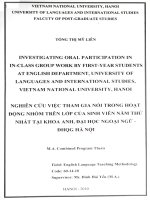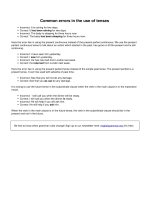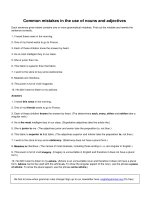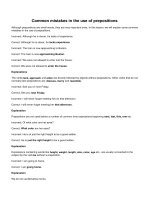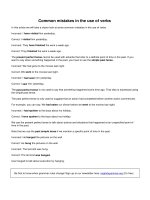Perceptions towards the use of TFLAT dictionary in english vocabulary learning by first year major english students at faculty of foreign languages, hanoi pedagogical university 2 and suggestions for users
Bạn đang xem bản rút gọn của tài liệu. Xem và tải ngay bản đầy đủ của tài liệu tại đây (1.51 MB, 56 trang )
HANOI PEDAGOGICAL UNIVERSITY 2
FACULTY OF FOREIGN LANGUAGES
-----------------------------------
CHU THI HUONG THAO
PERCEPTIONS TOWARDS THE USE OF TFLAT
DICTIONARY IN ENGLISH VOCABULARY LEARNING
BY FIRST-YEAR MAJOR ENGLISH STUDENTS AT
FACULTY OF FOREIGN LANGUAGES, HANOI
PEDAGOGICAL UNIVERSITY 2 AND SUGGESTIONS
FOR USERS
(Graduation paper submitted in partial fulfillment of the
Degree of Bachelor of Arts in English)
Supervisor: PHAM THI TUAN, M.A
Hanoi, May 2018
Acknowledgements
I would like to express my sincere gratitude to my supervisor, Ms.
Pham Thi Tuan. She is very enthusiastic to give me the valuable suggestion
for the problems that I had during the process of doing the research.
Besides, I am indebted to all the lectures at Hanoi Pedagogical
University 2, Hanoi Pedagogical University 2 especially the lectures at
Faculty of Foreign Languages for their help and support.
I also owe my special thanks to the first-year Major English students at
Faculty of Foreign Languages, Hanoi Pedagogical University 2. If I had had
no their support, I would not have completed the research on time.
Last but not least, I am grateful to my close friends for their
contribution to my study.
ABSTRACT
Nowadays, English has become an international language and the most
widely spoken language in the world. One of the most important components
of English language is English vocabulary. This study is about the perceptions
of fifty first-year Major English students towards the use of TFlat Dictionary
in their English vocabulary learning. The primary methods of this research
were survey questionnaire and interviews. The study focuses on the
perceptions towards the use of TFlat Dictionary. The research findings show
that TFlat Dictionary has both benefits and drawbacks. The research also
gives some suggestions for the use of this application in their English
vocabulary learning.
STATEMENT OF AUTHORSHIP
Title:
PERCEPTIONS TOWARDS THE USE OF TFLAT DICTIONARY IN
ENGLISH VOCABULARY LEARNING BY FIRST-YEAR MAJOR
ENGLISH STUDENTS AT FACULTY OF FOREIGN LANGUAGES,
HANOI PEDAGOGICAL UNIVERSITY 2 AND SUGGESTIONS
FOR USERS
(Graduation paper submitted in partial fulfillment of the Degree of
Bachelor of Arts in English)
I certify that I have not copied study from any others’ reports without
acknowledgment and this work is written by my best under the instruction
from my supervisor.
Date of submission: May 2018.
Student
Supervisor
Chu Thi Huong Thao
Pham Thi Tuan
LIST OF THE TABLES AND FIGURES
Tables:
Table 1
The frequency for studying the aspects of English vocabulary
Table 2
Ranks of groups of English vocabulary to be learned with TFlat
Dictionary
Table 3
Students’ frequency for using TFlat Dictionary’s functions
Table 4
Ranks of aspects of English vocabulary based on the effectiveness
of TFlat Dictionary
Table 5
Students’ opinions about the effectiveness of TFlat Dictionary
Figures:
Figure1
Students’ time spent on English vocabulary learning
Figure 2
Students’ interest in learning groups of English vocabulary
Figure 3
Students’ strategies in learning English vocabulary
Figure 4
Students’ time spent on English vocabulary learning with TFlat
Dictionary
Figure 5
Students’ opinions on TFlat Dictionary’s drawbacks
Figure 6
Students’ reasons for not using TFlat Dictionary in English
vocabulary learning
Figure 7
Students’ expectations towards TFlat Dictionary
LIST OF ABBREVIATIONS
1. HPU2
: Hanoi Pedagogical University 2
2. FFL
: Faculty of Foreign Languages
4. L2
: the second language
5. AWL
: Academic Word List
6. TOEIC
: Test of English for International Communication
7. IELTS
: International English Language Testing System
8. TOEFL
: Test Of English as a Foreign Language
9. SA
: Strongly Agree
10. A
: Agree
11. U
: Uncertain
12: D
: Disagree
13. SD
: Strongly Disagree
TABLE OF CONTENTS
Acknowledgements .............................................................................................
ABSTRACT ........................................................................................................
STATEMENT OF AUTHORSHIP ....................................................................
LIST OF THE TABLES AND FIGURES ..........................................................
LIST OF ABBREVIATIONS .............................................................................
TABLE OF CONTENTS ....................................................................................
PART A: INTRODUCTION ............................................................................ 1
1. Rationale........................................................................................................ 1
2. Aim of the study and Research Question ...................................................... 2
3. The scope of the study................................................................................... 3
4. Methods of the study ..................................................................................... 3
5. The significance of the study ........................................................................ 3
6. Overview of the study ................................................................................... 3
PART B: DEVELOPMENT ............................................................................. 5
CHAPTER I: LITERATURE REVIEW ........................................................... 5
1. Vocabulary .................................................................................................... 5
1.1. Definitions of vocabulary ....................................................................... 5
1.2. Aspects of Vocabulary Knowledge ........................................................ 5
1.2.1. Meaning ............................................................................................ 5
1.2.2. Pronunciation .................................................................................... 6
1.2.3. Grammar ........................................................................................... 6
1.2.4. Word Formation ................................................................................ 6
1.2.5. Collocations ...................................................................................... 7
1.2.6. Idioms ............................................................................................... 7
1.2.7. Connotation ....................................................................................... 7
1.2.8. Register ............................................................................................. 8
1.3. Four major groups of vocabulary............................................................ 8
1.3.1. High-frequency words ...................................................................... 8
1.3.2. Academic vocabulary ....................................................................... 8
1.3.3. Technical words ................................................................................ 8
1.3.4. Low frequency words ....................................................................... 9
2. Vocabulary learning strategies.................................................................... 9
2.1. Using Context Clues ............................................................................... 9
2.2. Mnemonics .............................................................................................. 9
2.3. Word Part Analysis ................................................................................. 9
2.4. Learning from Word Lists and Flashcards ........................................... 10
2.5. Incidental Vocabulary Learning from Reading .................................... 10
2.6. Using dictionary applications ............................................................... 10
3. The use of dictionary applications in English vocabulary learning ............ 11
3.1. The use of applications in English vocabulary learning ....................... 11
3.2. The use of dictionaries in English vocabulary learning........................ 11
4. TFlat Dictionary .......................................................................................... 12
4.1. English- Vietnamese translation ........................................................ 12
4.2. Vietnamese- English translation ........................................................ 12
4.3. Quickly Translating Window ............................................................ 13
4.4. Text Translation ................................................................................. 13
4.5. VIP Vocabulary ................................................................................. 13
4.6. Your Vocabulary................................................................................ 13
4.7. Searched Vocabulary ......................................................................... 14
4.8. Important Vocabulary ........................................................................ 14
4.9. Other Applications ............................................................................. 15
4.10. Setting .............................................................................................. 15
CHAPTER II: METHODOLOGY.................................................................. 16
1. Participants .................................................................................................. 16
2. Data collection instruments ......................................................................... 16
2.1. Questionnaire ........................................................................................ 16
2.1.1. Reasons for using Questionnaire: ................................................... 16
2.1.2. Description of questionnaire ........................................................... 16
2.2. Interview ............................................................................................... 17
2.2.1. Reasons for using Interview ........................................................... 17
2.2.2. Description of interview ................................................................. 17
3. Data collection procedure ........................................................................... 17
CHAPTER III: FINDINGS AND DISCUSSION .......................................... 19
1. Findings and discussion .............................................................................. 19
2. Implications ................................................................................................. 33
PART C: CONCLUSION ............................................................................... 35
1. Major findings ............................................................................................. 35
2. Limitations of the study .............................................................................. 35
3. Suggestion for further studies ..................................................................... 36
REFERENCE .................................................................................................. 37
APPENDIX .........................................................................................................
PART A: INTRODUCTION
1. Rationale
Nowadays, English has become an international language and the most
widely spoken language in the world. According to Crystal (2003), there are
320-380 million people whose first language is English and 300-500 million
people whose second language is English. Moreover, English is a foreign
language in some countries such as Philippines and Spain.
The increasing popularity of English can be explained by the fact that
having a good command of English gives better job opportunities or job
promotion. Since English is spoken in so many different countries, there are
thousands of schools around the world that offer programmes in English. If
you speak English, there are many opportunities for you to find an appropriate
school and course to suit your academic needs.
One of the most important components of English language is English
vocabulary. According to Luppescu and Day (1993: 266), "Building a large
vocabulary is essential when learning English because people with large
vocabularies are more proficient than those with limited vocabularies‖. In
other words, when students have lots of vocabulary, they can communicate
more competently than those who lack vocabulary. Therefore, students should
have enough English vocabulary to be able to undertake their studies
successfully. Having a wide range of English vocabulary is important for
anyone to use the language in real life as well as in academic fields.
Vocabulary learning is considered ―central to language acquisition‖
(Decarrico, 2001), whether first, second, or foreign. It means that learning
vocabulary is the prior component that must be given to the students during
their language learning. However, English learners still find it hard to acquire
new or unfamiliar words as well as memorize them.
1
Thanks to mobile Internet-connected devices, the mobile device
ecosystems led to the rise of thousands of free or almost free applications
(apps), ―which refer to compute programs designed to run exclusively on
mobile devices‖ (Qizhen Deng & Guy Trainin, 2015). Along with the
potential, however, the burden of selecting apps that can support learning can
bring confusion to students and teachers. At the same time, there is an
emergence of an application on the mobile phone called TFlat Dictionary.
This application is quite common and easy to download and install. TFlat
occupies a small memory size of the mobile phone, and it is easy to use.
As a teacher of English in the future, the researcher understands that a
teacher plays a significant role in students’ vocabulary learning process and
the teacher should adopt appropriate teaching strategies to facilitate learning.
She would like to carry out this research with the hope of finding out
perceptions towards what ways first-year Major English students use TFlat
Dictionary in English vocabulary learning. Particularly, her interest goes to
the first-year Major English students who need to get on well with a new
learning environment in the university and are in need of a tool that can help
in their learning process.
To sum up, the importance of English vocabulary learning, the
convenience of TFlat Dictionary and the need of the first-year Major English
students accelerate the researcher to carry out this study.
2. Aim of the study and Research Question
2.1. Aim of the study
The study is carried out to investigate the perceptions of first-year
Major English students towards the use of TFlat Dictionary in English
vocabulary learning and suggestions for users of TFlat dictionary.
2.2. Research Questions
The study attempts to answers the questions:
2
Q1: What are the perceptions of first-year Major English students at
FFL, HPU2 towards the use of TFlat Dictionary in English vocabulary
learning?
Q2: What suggestions can be made for users of TFlat dictionary?
3. The scope of the study
This study investigates the use of TFlat Dictionary in English
vocabulary learning. Due to the limited time and the limited size, the study
focuses on how first-year Major English students at FFL, HPU2 use TFlat
Dictionary and their perceptions on this application.
4. Methods of the study
To achieve the aims of the study, the methods that have been applied
are survey questionnaire and interviews. The participants of the study are the
English-majored freshmen at FFL, HPU2.
5. The significance of the study
The study aims to find out the ways English-majored first-year students
use TFlat Dictionary and their perceptions towards the use of this application
in their English vocabulary learning. The study also presents TFlat
Dictionary’s strengths and weaknesses to help students use it effectively in
English vocabulary learning. As for the theoretical field, this study is
expected to make a minor contribution to the research of blended learning. As
for English language teaching, the study suggests the use of Information
Technology solutions in English learning for both teachers and students of
English.
6. Overview of the study
This study is divided into three parts as follows:
Part A, Introduction, offers an overview of Rationale, Aims of the
study, Research questions, Scope of the study, Methods of the study and
Significance of the study.
3
Part B, Development, gives information on Literature Review,
Methodology, Findings and Discussion and Implications of the study.
Chapter I, Literature Review, presents theoretical background
knowledge about Vocabulary and TFlat Dictionary.
Chapter II, Methodology, describes in detail the Participants, Research
instruments employed and Procedure of data collection analysis.
Chapter III, Findings and discussion, analyzes gathered data and
presents the discussion of research findings, and Implications.
Part C, Conclusion, reviews Major findings, Limitations, and
Suggestion for further study.
4
PART B: DEVELOPMENT
CHAPTER I: LITERATURE REVIEW
1. Vocabulary
1.1. Definitions of vocabulary
According to Dr. Alfaki (2015:1), ―Vocabulary can be defined as single
items and phrases or chunks of several words which convey a particular
meaning, the way individual words do.‖ Vocabulary is not only the ―single
lexical items—words with specific meaning(s)‖ (Alfaki, 2015) but it also
includes phrases.
Hatch and Brown (1995:1) defined vocabulary as a list of words for a
particular language or a list or set of word that individual speakers of
language might use.
Roget (1980:1036) stated that vocabulary is:
- A list of words often defined or translated.
- All the words of Language.
- Specialized expressions which are indigenous to a particular field,
subject, trade or subculture.
In general, it can be said that vocabulary is an essential part of a
language which consists of a system of single words or word sets relating to
one another. The speakers might use vocabulary to convey the information
and interact with others.
1.2. Aspects of Vocabulary Knowledge
According to West, C. M. and West, R. (2012), there are several
aspects of Vocabulary Knowledge.
1.2.1. Meaning
Nation (2001) stated that meaning encompasses the way that form and
meaning work together, in other words, the concept and what items it refers
to, and the associations that come to mind when people think about a specific
5
word or expression. Therefore, the meaning is one of the most significant
factors to understand a word. Thornbury (2002: 15) declared that students
learning the meaning could learn its connotations, register, and cultural
accretions. Students need to not only learn single words but also study phrases
as well as collocations, depending on students’ level, to use them exactly in
any situation.
1.2.2. Pronunciation
English pronunciation is one of the most difficult skills to acquire and
learners should spend lots of time to improve their pronunciation (Gilakjani,
2016:2). Pronunciation is the act or result of producing the sounds of speech,
including articulation, stress, and intonation, often concerning some standard
of correctness or acceptability. However; incorrect pronunciation can lead to
negative impression, misunderstanding and ineffective communication. When
learning a word, students should know its pronunciation, which is meaningful
in fluency and accuracy.
1.2.3. Grammar
It is defined as ―the rules that govern how a language’s sentences are
formed‖ (Thornbury, 2000:1). Grammar is the set of structural rules which
influences the composition of clauses, phrases, and words in any given
language. It is the systematic study and description of a language, and it helps
us to understand how words and their parts combine to form sentences.
Grammar clarifies how the language should be structured, using various
categories. These grammatical features include: followed with a verb, with a
verb that needs an object or with a particular word (prepositions).
1.2.4. Word Formation
Nation (2001) stated that students could study unfamiliar words by
connecting to known words and check word guessing. According to Adejumo
and Osunbade (2014), word formation is conceived of as the process by which
6
words are brought into existence. A word is located within morphemes. As a
result, a large number of English words are formed through affixation and other
word formation processes such as blending, clipping, compounding, etc.
1.2.5. Collocations
Pawley and Syder(1983)proposed that one of the reasons native
speakers can speak instantly without thinking about building phrases is
collocation. Collocation is the way words work together to sound natural in a
particular context. For example, we might say ―The typhoon brought heavy
rain and strong winds‖, but we would not say that it brought ―strong rain‖ or
―heavy winds‖. Those combinations do not collocate. Choosing the right
collocation will enable you to express yourself more precisely and will draw
attention to where it should be on the content of what you have to say, not on
how you are saying it.
1.2.6. Idioms
According to West and West (2012), idiomatic expression can only be
learned through memorization. For example, ―break a leg‖ which would mean
to have good luck. However; English textbook is often lacking in such
expressions. An idiom is a phrase that has a meaning that cannot be
understood from the knowledge of its parts. Linguists also use the word
formative to describe idioms.
1.2.7. Connotation
According to West and West (2012), two words may have the same
meaning in dictionary definition, but they are used in different way to express
the different sense of native speaker. The connotation includes semantic or
stylistic elements which are connected in a certain way with the basic
meaning and are superimposed upon it. Connotation is used to express
emotional.
7
1.2.8. Register
Register concerns the politeness and relationship between speakers. For
example, the way students talk to their friends is different from that to their
teachers. Register is characterized by ―differences in the type of language
selected as appropriate to different types of the situation‖ (Halliday et al.
1964), which means that there is a close relationship between language and
context of the situation.
1.3. Four major groups of vocabulary
Nation (2001) stated that there were four major groups of vocabulary.
1.3.1. High-frequency words
High-frequency words are listed in the General Service List, created by
Michael West in 1953. These words are sometimes called tricky words, sight
words or camera words. High-frequency words are quite simply those words
which occur most frequently in written material, for example, "and,‖ "the,‖
"as" and "it" (Nation, 2001). They are often words that have little meaning on
their own, but they do contribute a great deal to the meaning of a sentence.
1.3.2. Academic vocabulary
Nation(2008:125)stated ―that the 570-word families make up around
10% of the running words in the academic text, about 4% in newspapers and
less than 2% of novels.‖ Academic Word List (AWL), was developed by
Coxhead (2000). The corpus of this study was 3.5 million running words that
the texts of her corpus were selected from different academic journals and
university textbooks in four main areas: arts, commerce, law and natural
science.
1.3.3. Technical words
This group includes technical words like: timber, regeneration,
porpcarp, beech, rimu (Nation, 2001) and so on. Technical vocabulary is
closely related to one specific subject and may require learners to have
8
specialist knowledge to understand it (Chung & Nation, 2004). Learning
technical words plays an important role in learning about a particular
discipline.
1.3.4. Low frequency words
According to West and West (2012), low frequency words are words
that uncommonly occur in a language, such as ―apopemptic,‖ ―diaphoretic,‖
and ―rebarbative‖ in English. Low-frequency words produce more hits and
fewer false alarms than high-frequency words in a recognition task.
2. Vocabulary learning strategies
According to Kulikova (2015), there are several vocabulary learning
strategies, as can be seen below.
2.1. Using Context Clues
Research by Nagy and Scott (2000) showed that students use contextual
analysis to infer the meaning of a word by looking closely at surrounding text.
People learn vocabulary from listening and because they have ―the luxury of
multiple exposures to words over time in a variety of meaningful contexts‖
(Folse, 2004:130). Native speakers learning their first language receive a lot of
language input from everyday conversations and media.
2.2. Mnemonics
Mnemonic strategies are based on cognitive processes that are
considered to facilitate faster learning, retrieval, and retention of material.
They can be classified into verbal, visual, or mixed techniques. They include
creating mental associations, applying images and sounds, using rhymes,
verbal elaboration, reviewing in time intervals, self-testing, and using physical
response (Thompson, 1987).
2.3. Word Part Analysis
Gaining control of prefixes, suffixes and other word-building devices
may be a source of vocabulary growth: New words may be learned by relating
9
them to known ones, and guessing unfamiliar words in readings can be
checked using knowledge of word parts (Nation, 2001). Mochizuki & Aizawa
(2000) found a significant correlation between receptive knowledge of
derivational affixes and vocabulary size in L2 students.
2.4. Learning from Word Lists and Flashcards
Many textbooks contained lists of words that students were supposed to
memorize and then use when needed. Flashcard was a popular method
learners used to memorize words. While advanced learners may benefit from
learning vocabulary in context, beginners learn words more easily if they are
presented in lists of translation pairs (Laufer and Shmueli, 1997).
2.5. Incidental Vocabulary Learning from Reading
Although L2 learners are not found to be very successful in inferencing
new word meanings from reading (Schmitt, Jiang, & Grabe, 2011), reading
may deepen and strengthen the knowledge of partially known words (Pigada
& Schmitt, 2006). Nation (2001) argues that learning from context is a
cumulative process, and even small increases in knowledge should be taken
into account. The quality of gained knowledge depended on the frequency of
occurrence of the target words in the text.
2.6. Using dictionary applications
According to Deng and Trainin (2015), digital dictionaries solve the
problem of cognitive load, allowing students to quickly and efficiently find a
definition, etymology, use an example and even audio of pronunciation. In
productive ways, learners can find the wanted word forms, check that there
are no unwanted constraints on the use of the word, work out the grammar
and collocations of the word, and check the spelling or pronunciation of the
word before using it.
10
3. The use of dictionary applications in English vocabulary learning
3.1. The use of applications in English vocabulary learning
As for affordances provided by technology, Klopfer and Squire (2008)
discussed five advancements including: portability—mobile devices can be
easily carried and used anywhere, social interactivity—mobile devices can be
used for collaborative work, context sensitivity—mobile devices affords
authentic contexts, connectivity— mobile devices are connected to other
devices through an array of local and cellular networks, and individualizing
instruction—apps on personal devices can provide user-specific scaffolding
based on individual preferences and personal learning progress. These
qualities open new opportunities for individualized learning and practice.
There is a fit between the affordances of mobile devices and the needs of
vocabulary learners.
3.2. The use of dictionaries in English vocabulary learning
According to Nation (2001), dictionaries serve three purposes:
1) comprehension – look up unknown words or confirm word deduced
from context during listening, reading, or translating;
2) production – look up unknown words or word parts needed for
speaking, writing, and translating;
3) learning – enrich knowledge of known words, such as etymology or
different contextual usages.
English dictionary is a very important tool for anyone who is learning
the English language. Retrieved from www.teachingenglish.org.uk, the
dictionary is a handy resource to develop vocabulary learning, researching
different meanings, collocations, examples of use and standard pronunciation.
Retrieved from www.britishcouncil.org/, a good dictionary is not just a
list of isolated words with their meanings or translations. The job of the
dictionary is to place a word in each of its possible contexts and explain its
meaning in each case.
11
4. TFlat Dictionary
Retrieved from , some items are
useful and common to the students learning English vocabulary.
4.1. English- Vietnamese translation
This item can help students to translate English into Vietnamese. After
they look up a word, its meanings appear with some examples that illustrate
the meanings. Moreover, learners have a chance to listen to the pronunciation
and have knowledge about its part of speech as well as the synonyms and
antonyms. If students gradually update the new versions of this application,
they can learn English vocabulary with images.
4.2. Vietnamese- English translation
This function of TFlat Dictionary helps students to translate
Vietnamese to English. Learners only type the Vietnamese words exactly and
then press the Search icon. Students are also provided with some examples of
each word.
For example, when students type the word ―từ điển‖, this application
will show the word ―dictionary‖. That is the way this function works.
12
4.3. Quickly Translating Window:
The item is available on mobile screen with an icon, and the user can
access easily.
4.4. Text Translation
As long as the phone connects to the Internet, a long text can be
translated. However, this utility is not used regularly by students because they
do not have access to the Internet anytime.
4.5. VIP Vocabulary
Learners have to have Internet access to use this function. Thanks to
this item, students will have the opportunity to learn English vocabulary with
more games and images.
4.6. Your Vocabulary
Students can save words that were marked with a star and will be
reminded when you set up. Besides, learners can revise these words with the
section Revision and then practice with a game. A word will not be in the
piece if students delete it.
13
4.7. Searched Vocabulary
There are about five hundred recently translated words that are saved in
this item. In this part, there is also a game to help students learn new words.
Meanwhile, like Your vocabulary, this function also contains images for
words if students have a VIP card.
4.8. Important Vocabulary
This part is divided into five categories: irregular verbs, TOEIC
vocabulary, IELTS vocabulary, TOEFL vocabulary, 3000 Oxford vocabulary.
That is useful for students to focus on learning vocabulary with each category.
14
4.9. Other Applications
This part has some other applications students can use, such as BBC
Learning English, Dynamic English, English Listening, English Test, Daily
Learn English and Game for TOEIC Vocabulary.
4.10. Setting
The most important thing in this part is prompting that will remind
students after they set up times and pronunciation. Besides, students can know
the version of the application that they are using.
TFlat Dictionary is a new dictionary application that has not been
studied by any researchers while it is common to the students. That is also the
reason why I carry out a study about TFlat Dictionary.
15
CHAPTER II: METHODOLOGY
1. Participants
The participants of this study were 50 first-year English majors. They
(in their 17-19 years old) were students from K43 of Faculty of Foreign
Languages of Hanoi Pedagogical University 2, having spent at least three
years learning English. Some of them have used TFlat Dictionary in English
vocabulary learning while some others have not. They took part in the survey
in January 2018 and answered some questions.
Ten of the participants were selected for interviews. They are chosen
due to their long time in using TFlat Dictionary in English vocabulary
learning. The interviews aimed to collect their detailed opinions on the use of
TFlat Dictionary. The data were audio-recorded for analysis.
2. Data collection instruments
Data were collected from two main instruments: survey questionnaire
and interview.
2.1. Questionnaire
2.1.1. Reasons for using Questionnaire:
This study used a questionnaire to collect the data in a quantitative
form which focuses ―rigorous quantitative analysis‖ (Kothari, 2004). The
questionnaire is not only practical but also can be carried out by the
researcher or by any number of people. Large amounts of information can be
collected from a large number of people in a short period and in a relatively
cost-effective way. The results of the questionnaires can usually be quickly
and easily quantified by the researcher and can be analyzed more
scientifically and objectively than other forms of research.
2.1.2. Description of questionnaire
In part I, Perceptions towards English vocabulary learning, the students
were asked about such information as: the amount of time, the frequency and
their opinions toward English vocabulary learning
16

